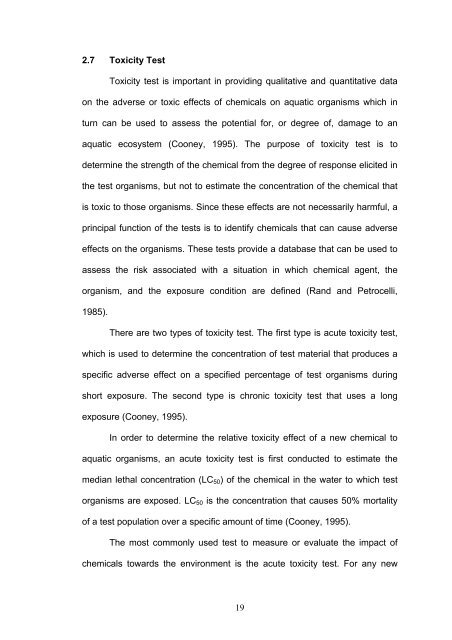IDENTIFICATION OF COPPER-INDUCIBLE GENES IN Pistia stratiotes
IDENTIFICATION OF COPPER-INDUCIBLE GENES IN Pistia stratiotes
IDENTIFICATION OF COPPER-INDUCIBLE GENES IN Pistia stratiotes
You also want an ePaper? Increase the reach of your titles
YUMPU automatically turns print PDFs into web optimized ePapers that Google loves.
2.7 Toxicity Test<br />
Toxicity test is important in providing qualitative and quantitative data<br />
on the adverse or toxic effects of chemicals on aquatic organisms which in<br />
turn can be used to assess the potential for, or degree of, damage to an<br />
aquatic ecosystem (Cooney, 1995). The purpose of toxicity test is to<br />
determine the strength of the chemical from the degree of response elicited in<br />
the test organisms, but not to estimate the concentration of the chemical that<br />
is toxic to those organisms. Since these effects are not necessarily harmful, a<br />
principal function of the tests is to identify chemicals that can cause adverse<br />
effects on the organisms. These tests provide a database that can be used to<br />
assess the risk associated with a situation in which chemical agent, the<br />
organism, and the exposure condition are defined (Rand and Petrocelli,<br />
1985).<br />
There are two types of toxicity test. The first type is acute toxicity test,<br />
which is used to determine the concentration of test material that produces a<br />
specific adverse effect on a specified percentage of test organisms during<br />
short exposure. The second type is chronic toxicity test that uses a long<br />
exposure (Cooney, 1995).<br />
In order to determine the relative toxicity effect of a new chemical to<br />
aquatic organisms, an acute toxicity test is first conducted to estimate the<br />
median lethal concentration (LC50) of the chemical in the water to which test<br />
organisms are exposed. LC50 is the concentration that causes 50% mortality<br />
of a test population over a specific amount of time (Cooney, 1995).<br />
The most commonly used test to measure or evaluate the impact of<br />
chemicals towards the environment is the acute toxicity test. For any new<br />
19








![[Consumer Behaviour] - ePrints@USM](https://img.yumpu.com/21924816/1/184x260/consumer-behaviour-eprintsusm.jpg?quality=85)








